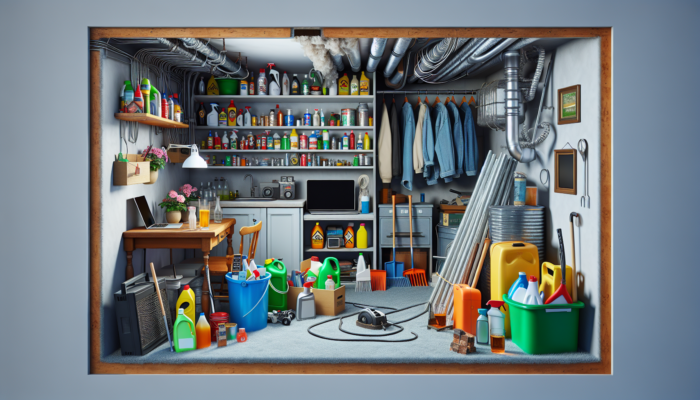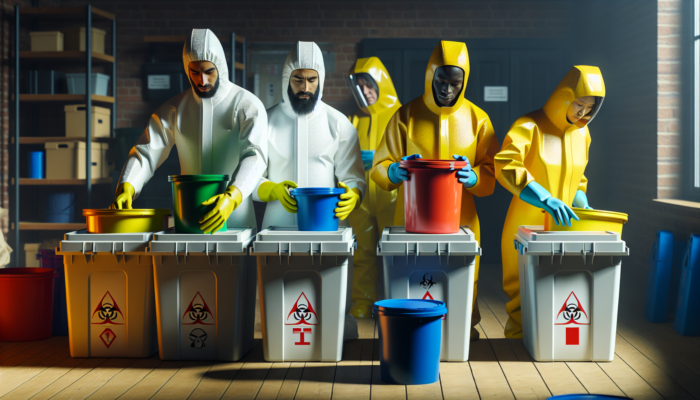Effective Strategies for Safely Managing Hazardous Waste During House Clearance Projects
When undertaking a house clearance, one may encounter various forms of hazardous waste, which carry substantial risks that necessitate careful handling. The success of this intricate process hinges on the precise identification of dangerous materials, selection of suitable personal protective equipment (PPE), and strict adherence to legal regulations related to waste disposal. This section serves as a crucial resource, providing indispensable advice on these integral aspects, ensuring that your house clearance is conducted safely, legally, and effectively.
Recognizing Hazardous Materials: Key Types and Their Common Locations Within Your Home

The first essential step in effectively managing hazardous waste during house clearance is accurately identifying what qualifies as hazardous materials. These substances are often located in various areas throughout a home and can be hidden in unexpected spots. Common examples of hazardous waste include chemicals, batteries, asbestos, paints, and electronic waste that may be lurking in attics or basements.
Chemicals, including cleaning agents, solvents, and pesticides, are typically stored in areas such as under sinks or in garages. Batteries may be found in outdated electronic devices or gardening tools, while asbestos, a highly hazardous fibrous material formerly utilized in insulation and fireproofing, can be concealed within older homes' walls, particularly in attics or basements. Additionally, paints, especially those containing lead or potent solvents, are often stored in sheds or beneath staircases. Lastly, electronic waste, which encompasses obsolete computers, televisions, and mobile phones, may also contain hazardous components necessitating specialized handling.
To ensure safety, it is advisable to conduct an initial walkthrough of the property to pinpoint these materials effectively. Collaborating with professional clearance services that specialize in hazardous waste management can provide invaluable support. These experts are trained to identify dangerous substances and can take the necessary steps for their safe and effective handling.
Personal Protective Equipment Essentials: Gear Required for Safe Management of Hazardous Waste
Once hazardous materials have been identified, equipping oneself with the right personal protective equipment (PPE) becomes critically important. The nature of the hazardous waste encountered will determine the specific gear needed; however, there are several essential items that everyone involved in the clearance process should have readily available.
Primarily, gloves are vital for preventing direct skin contact with toxic substances. Nitrile gloves, in particular, offer effective protection against chemicals and sharp objects, providing a strong barrier. Furthermore, protective eyewear is crucial for safeguarding the eyes from splashes of liquids or airborne particles. When working in environments with dust, fumes, or vapors, especially confined spaces, appropriate respiratory protection, such as masks or respirators, is essential.
Moreover, suitable clothing should be worn to minimize exposure risks. Disposable overalls or sturdy work attire can shield against chemical spills and add an extra layer of safety. Steel-toed boots are also advisable to protect feet from falling objects or sharp debris.
Ultimately, the correct PPE not only protects individuals during house clearance but also instills confidence that the process is being conducted safely and responsibly.
Compliance with Legal Standards: Understanding Regulations for Safe Management of Hazardous Waste
Understanding the legal framework surrounding hazardous waste in-house clearance is crucial for ensuring compliance and safeguarding oneself from potential legal repercussions. Numerous regulations govern the handling, storage, and disposal of hazardous materials, making it essential to be well-versed in these requirements.
In the UK, the Hazardous Waste Regulations 2005 mandate that hazardous waste must be managed according to specific guidelines. This includes accurate classification, secure storage of hazardous waste, and maintaining precise records of its disposal. Failure to comply with these regulations can lead to significant fines and legal penalties.
Additionally, local regulations must be taken into account, as different regions may have additional requirements. Engaging with local authorities and environmental agencies can provide clarity on compliance obligations.
Individuals opting for professional clearance services should ensure that these companies are licensed and knowledgeable about hazardous waste management regulations. This not only guarantees compliance but also offers peace of mind that the clearance process is being executed legally and safely.
Proven Techniques for Efficiently Managing Hazardous Waste During House Clearance

Effectively managing hazardous waste during house clearance is vital for ensuring safety and compliance. This section outlines key strategies, including sorting and segregation, containment and storage, as well as transportation methods, all aimed at facilitating a successful clearance process.
Best Practices for Efficiently Sorting and Segregating Hazardous Waste
A systematic approach to sorting and segregation is essential when managing hazardous waste. Best practices advise categorizing materials based on their type and hazard level, streamlining the clearance process and ensuring that appropriate handling protocols are adhered to for each category of waste.
Begin by establishing designated areas for different types of waste, including chemicals, electronics, and sharp objects. Labeling these zones effectively prevents cross-contamination and ensures safe storage of materials. For instance, chemicals should be isolated from electronic waste, as reactions between certain substances can create hazardous conditions.
Utilizing color-coded bins or containers can enhance organization. For example, using red for hazardous waste and green for recyclable materials aids in quick identification and minimizes the risk of errors. Regular inspections should be conducted to ensure waste is sorted accurately and that containers do not exceed their capacity.
Incorporating these sorting and segregation practices into your hazardous waste management strategy can significantly improve both efficiency and safety during house clearance.
Safe Containment and Storage: Strategies for Temporarily Holding Hazardous Waste
After hazardous materials have been sorted, the next priority should be on containment and storage. Safe methods for temporary holding are essential to prevent leaks, spills, or accidents that could endanger individuals and the environment.
One effective strategy is to utilize robust, leak-proof containers specifically designed for hazardous waste. These containers should be clearly labeled with appropriate hazard symbols to inform anyone handling them of the potential dangers. Furthermore, they should be stored in a dry, secure location away from the main areas of activity to minimize the risk of accidental exposure.
Adhering to the principle of compatibility is critical when storing hazardous waste. This means that materials that could react negatively with one another must be stored separately — for instance, flammable substances should not be kept near oxidizing agents, as this could lead to dangerous reactions.
Regular monitoring of storage areas is necessary to ensure that containers remain intact and that no leaks or spills have occurred. Establishing a clear protocol for inspecting these areas can help maintain a safe environment throughout the house clearance.
Guidelines for the Safe Transportation of Hazardous Materials

Transporting hazardous materials safely is critical to managing dangerous waste during house clearance. Adhering to specific guidelines can mitigate risks during the movement of these substances from the property to disposal locations.
Before transportation, ensure that all hazardous waste is securely contained and accurately labeled. This not only aids in safe handling but also communicates the associated risks to anyone involved in the transportation process. It's advisable to utilize vehicles specifically designed for transporting hazardous materials, as they are equipped with features such as spill containment systems and proper ventilation.
During transit, it is vital to observe speed limits and avoid sudden stops that could lead to spills or accidents. Additionally, drivers should be trained in handling hazardous materials and be familiar with emergency response protocols in case of an incident.
Upon reaching the disposal facility, follow established procedures for unloading and disposing of the hazardous waste. This ensures the entire process complies with legal regulations while prioritizing safety at every stage.
Expert Insights and Best Practices for Effectively Managing Hazardous Waste During House Clearance
Gaining insights from industry experts can provide invaluable guidance on managing hazardous waste during house clearance. This section explores case studies, expert recommendations, and the importance of training and certification for ensuring effective waste management.
Case Studies: Learning from Real-Life Success Stories in Hazardous Waste Management
Examining case studies of successful hazardous waste management can offer practical insights into effective strategies and techniques. A notable case involved the clearance of an old industrial site where various hazardous materials, including chemicals and asbestos, were discovered.
In this instance, the clearance team devised a comprehensive plan that initiated with a thorough site assessment, followed by careful categorization of hazardous materials. They collaborated closely with environmental agencies to ensure compliance with regulations and engaged specialized contractors to safely remove asbestos.
The result was a successful clearance that prioritized safety and minimized environmental impact. This case highlights the importance of meticulous planning, regulatory compliance, and collaboration with professionals in the field.
Expert Recommendations: Professional Advice for Safely Handling Hazardous Substances
Industry professionals possess valuable knowledge when it comes to best practices for managing hazardous waste during house clearance. One crucial piece of advice is to never underestimate the importance of thorough training. Ensuring that all team members are well-informed about dangerous materials, their associated risks, and safe handling procedures is vital for maintaining safety throughout the process.
Another expert recommendation emphasizes the necessity of approaching hazardous waste with caution. If there is any uncertainty regarding a substance, it is advisable to consult with professionals rather than risking exposure. Furthermore, maintaining clear communication among team members during clearance can help ensure everyone is aware of potential hazards and safety protocols.
Lastly, experts stress the importance of having a contingency plan in place. This includes knowing how to respond to accidents, spills, or unexpected discoveries of hazardous materials. Preparedness significantly reduces risks and enhances overall safety during the clearance operation.
The Importance of Training and Certification in Hazardous Waste Management
Investing in training and certification is crucial for those involved in handling hazardous waste during house clearance. Proper training equips individuals with the necessary knowledge and skills to manage hazardous materials safely and effectively.
Certification programs encompass various aspects of hazardous waste management, from identification and storage to disposal protocols. These programs impart essential knowledge and demonstrate a commitment to safety and compliance, which can enhance credibility within the industry.
Moreover, ongoing training is vital to stay updated on the latest regulations and best practices. As regulations evolve and new hazardous materials emerge, continuous professional development ensures that individuals are informed and prepared to handle any challenges during house clearance.
Tailoring Hazardous Waste Management to Different Property Types: Practical Applications
Different properties present unique challenges when managing hazardous waste during house clearance. This section explores practical applications for residential clearances, commercial properties, and historic buildings, highlighting tailored approaches for each scenario.
Residential Clearances: Effectively Identifying and Managing Household Hazardous Waste
Residential clearances often involve hazardous household waste. Common items include old cleaning products, paints, batteries, and electronic devices. To effectively manage these materials, homeowners should conduct a comprehensive inventory of potential hazardous waste before commencing the clearance process.
Many local councils offer guidance on the proper disposal of household hazardous waste, including designated drop-off points or collection services. Homeowners are encouraged to utilize these resources to ensure safe and compliant disposal.
Additionally, homeowners should educate themselves about the potential risks associated with various materials. For example, lead-based paints can pose significant health risks, especially in homes with children. Understanding these dangers allows homeowners to approach the clearance process with the necessary caution and care.
Commercial Properties: Effectively Managing Hazardous Waste in Industrial and Office Settings
Commercial properties present their own set of challenges in managing hazardous waste during house clearance. Industrial sites may harbor hazardous materials such as chemicals, heavy metals, and waste from manufacturing processes, while office spaces may contain electronic waste and outdated machinery.
When dealing with industrial waste, it is crucial to engage professional clearance services that specialize in handling hazardous materials. These services can perform thorough assessments, implement appropriate safety measures, and ensure compliance with legal regulations.
For office clearances, businesses should consider implementing a clear waste management policy that outlines procedures for disposing of electronic waste and other hazardous materials. This not only streamlines the clearance process but also promotes sustainability and environmental responsibility.
Historic Buildings: Unique Considerations for Clearance of Older and Distinct Structures
Handling hazardous waste in historic buildings requires special considerations due to the unique materials often found in older structures. Asbestos, lead paint, and other dangerous materials may be hidden within these buildings’ walls, ceilings, or flooring.
Conducting a detailed assessment of the property is critical before beginning a clearance. Collaborating with specialists who are knowledgeable about historic building regulations and hazardous waste management can provide valuable insights and ensure adherence to preservation guidelines.
Moreover, any clearance activities should prioritize protecting the building’s historical integrity. This may involve employing specific techniques or tools to minimize damage while safely removing hazardous materials. By taking these precautions, property owners can ensure a successful clearance while preserving the structure’s historical significance.
Addressing Challenges in Hazardous Waste Management During House Clearance
Dealing with the challenges of handling hazardous waste during house clearance is essential for ensuring a smooth and safe process. This section discusses common obstacles, including unexpected discoveries, limited space, and time constraints, along with strategies to overcome them.
Managing Unexpected Discoveries: Protocols for Safely Handling Unforeseen Hazardous Materials
Unexpected hazardous materials can frequently surface during a house clearance. Whether it is a concealed stash of chemicals in a basement or outdated electronic devices, having established protocols for handling these discoveries safely is crucial.
Upon encountering unfamiliar substances, it is essential to cease all clearance activities in that area and thoroughly assess the situation. If there is any uncertainty regarding the safety of the material, it is advisable to contact a professional hazardous waste management service. They possess the expertise to evaluate potential risks and implement appropriate handling procedures.
Documenting the discovery and any actions taken is vital for compliance and future reference. This ensures that all steps taken are recorded, providing a clear trail of actions in accordance with legal requirements.
Strategies for Managing Waste in Confined Spaces: Effective Techniques for Safe Handling
Limited space can pose a significant challenge when handling hazardous waste during house clearance, particularly in smaller homes or cluttered environments. Strategic planning is essential for effectively managing waste in confined areas.
One effective strategy is to prioritize the clearance of hazardous materials first, thus minimizing their presence in the space. This approach enhances safety and facilitates the efficient use of available area.
Establishing a clear workflow can also aid in managing limited space. Designating specific areas for sorting and temporary storage can streamline the process. Additionally, utilizing vertical space for storage can maximize efficiency, allowing for safer movement within the confined area.
Efficient Methods for Quick and Safe Clearances: Streamlining the Process
Time constraints can significantly influence the handling of hazardous waste during house clearance. To overcome this challenge, employing efficient methods and techniques is vital for ensuring a swift yet safe process.
One approach is to develop a comprehensive plan before commencing the clearance. This plan should outline each team member’s specific tasks, timelines, and responsibilities. Establishing clear expectations allows the clearance process to remain focused and efficient.
Moreover, utilizing technology can enhance efficiency. Digital inventory management and communication tools can streamline operations, ensuring all team members are aligned and tasks are completed on time.
Lastly, engaging professional clearance services can expedite the process. Their expertise and resources can facilitate a swift clearance while adhering to all safety protocols and legal requirements.
Encouraging Environmental Sustainability in Hazardous Waste Management During House Clearance
The environmental implications of handling hazardous waste during house clearance are significant. This section explores eco-friendly disposal options, recycling and reuse opportunities, and the broader community effects of hazardous waste management.
Eco-Friendly Disposal: Emphasizing Sustainable Practices in Waste Management
Prioritizing eco-friendly methods for disposing of hazardous waste is crucial to mitigating environmental harm. Many local councils offer specialized disposal services for hazardous materials, ensuring they are treated and discarded in compliance with environmental regulations.
Additionally, exploring partnerships with certified hazardous waste disposal companies can provide access to environmentally responsible disposal methods. These firms typically utilize advanced technologies and processes that minimize the impact of hazardous waste on the environment.
Furthermore, individuals should consider participating in community hazardous waste collection events. These initiatives offer a safe and responsible way to dispose of hazardous materials while promoting awareness about environmental sustainability within the community.
Recycling and Reusing: Advocating for Sustainable Practices in Hazardous Waste Management
Integrating recycling and reuse opportunities into handling hazardous waste during house clearance can significantly bolster sustainability efforts. Many hazardous materials, such as batteries and electronics, can be recycled, reducing the demand for new resources and minimizing waste.
Homeowners and businesses should stay informed about local recycling programs and services to facilitate recycling. Many communities offer drop-off locations or collection events specifically for hazardous materials, simplifying responsible recycling.
Encouraging a culture of reuse can also contribute to sustainable waste management. For instance, old furniture, appliances, and electronics can often be refurbished or repurposed, extending their lifespan and diminishing the necessity for new purchases.
Community Impact: Acknowledging the Broader Effects of Hazardous Waste Management
The wider community impact of hazardous waste during house clearance is a vital consideration. Improper disposal of hazardous materials can lead to environmental contamination, posing risks to public health and safety.
Communities that prioritize responsible hazardous waste management contribute to a healthier environment for all residents. By implementing effective disposal methods and promoting awareness, communities can minimize the risks associated with hazardous materials and foster a culture of sustainability.
Engaging with local organizations and government initiatives can also enhance community efforts in hazardous waste management. Collaborative actions can improve education and resources, ultimately benefiting the entire community.
Frequently Asked Questions Regarding Hazardous Waste Management During House Clearance
What Types of Materials Are Classified as Hazardous Waste in House Clearances?
Hazardous waste in the context of a house clearance includes materials that pose significant risks to human health or the environment. Examples encompass chemicals, batteries, electronic waste, paints, and asbestos.
How Can I Safely Dispose of Hazardous Waste Found During Clearance?
Safely disposing of hazardous waste requires identifying the materials, securely containing them, and adhering to local regulations for disposal. Many councils provide designated drop-off points or collection services for hazardous waste.
What Are the Consequences of Improper Hazardous Waste Management?
Penalties for improper hazardous waste management can encompass substantial fines, legal action, and potential imprisonment. Compliance with local regulations is essential to avoid severe consequences.
How Can I Identify Hazardous Materials in My Home?
Identifying hazardous materials involves checking for common everyday items such as old paint, batteries, cleaning chemicals, and electronic devices. Consulting with professionals can also aid in accurate identification.
What Personal Protective Equipment Should I Use When Handling Hazardous Waste?
Recommended PPE includes gloves, protective eyewear, respiratory masks, and durable clothing. The choice of equipment depends on the specific hazardous materials being handled.
Are There Specific Regulations for Commercial Properties Regarding Hazardous Waste?
Yes, commercial properties must comply with specific regulations concerning hazardous waste management. These include adherence to the Hazardous Waste Regulations 2005 and local environmental laws.
Can I Recycle Hazardous Materials Discovered During House Clearance?
Many hazardous materials, including batteries and electronic waste, can be recycled. However, it is essential to check local recycling programs for proper disposal methods.
What Should I Do If I Encounter Hazardous Waste Unexpectedly?
If you discover hazardous waste unexpectedly, cease all activities in that area and carefully assess the situation. It is advisable to contact a professional hazardous waste management service for assistance.
How Can I Find Professional Help for Hazardous Waste Management?
To locate professional help, research local hazardous waste management companies with appropriate certifications and experience. Checking reviews and recommendations can also be beneficial.
What are the best practices for safely storing hazardous waste?
Best practices for safe hazardous waste storage include utilizing leak-proof containers, clearly labeling them, and storing them in a secure, dry location away from main activity areas. Regular inspections are also crucial.
Join our Facebook Community!
The Article: Managing Hazardous Waste in House Clearance: Essential Guide Was First Found At https://birminghamhouseclearance.com
The Article Essential Guide to Managing Hazardous Waste in House Clearance Was Found On https://limitsofstrategy.com


Your insights into the safe management of hazardous waste during house clearance projects undoubtedly shine a critical light on an often-overlooked aspect of home organization. The way you detail the need for proper identification and adherence to legal regulations really resonates with me. It reminds me of how complex our homes can be—not only as living spaces but also as repositories of materials we might not think twice about, yet pose significant risks.
You’ve touched on a really important point about how our homes can be more than just living spaces. They often hold a myriad of materials and memories that we might overlook until it comes time for a clearance. It’s fascinating—and somewhat daunting—how many hazardous substances can be hidden in plain sight, from old paint cans to batteries.